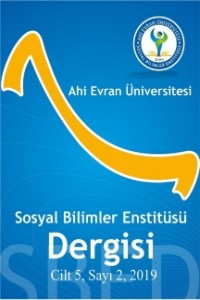Öz
Bu çalışmanın amacı, ortaokul beşinci
sınıf öğrencilerinin eşit işaretine ilişkin anlamalarını belirlemektir.
Araştırma nitel araştırma kapsamında yapılandırılmış bir durum çalışmasıdır.
Çalışma 15 ortaokul beşinci sınıf öğrencisi ile gerçekleştirilmiştir.
Araştırmanın çalışma grubu, amaçlı
örnekleme yöntemlerinden ölçüt örnekleme yöntemi ve kolay ulaşılabilir durum
örneklemesi kullanılmıştır. Araştırma verileri açık uçlu sorulardan oluşan bir
ölçme aracı ve yarı yapılandırılmış görüşme formu aracılığıyla toplanmıştır.
Çalışmaya katılan 15 öğrenci ölçme aracındaki soruları yanıtlamaları
istenmiştir. Bu öğrencilerin arasından belirlenen 5 öğrenci ile ise görüşmeler
gerçekleştirilmiştir. Verilerin analizinde içerik analizi ve betimsel analiz
kullanılmıştır. Araştırma sonucunda, çalışmaya katılan öğrencilerin çoğunun
eşit işaretini eşitliğin iki tarafındaki sayısal ilişkileri ifade eden bir
ilişkisel sembol olarak değil, sonuca götüren bir işlem sembolü olarak
gördükleri belirlenmiştir. Araştırmaya katılan az sayıda öğrenci eşitlikteki
sayısal ilişkileri kullanmıştır. Araştırmadan elde edilen bulgular ilgili alan
yazın kapsamında tartışılmış ve önerilerde bulunulmuştur.
Anahtar Kelimeler
Kaynakça
- Akkan, Y., Baki, A. ve Çakıroğlu, Ü. (2012). 5-8. sınıf öğrencilerinin aritmetikten cebire geçiş süreçlerinin problem çözme bağlamında incelenmesi. Hacettepe Üniversitesi Eğitim Fakültesi Dergisi, 43, 1-13.
- Behr, M., Erlwanger, S., ve Nichols, E. (1980). How children view the equals sign. Mathematics Teaching, 92, 13-15.
- Blanton, M., Otálora, Y., Brizuela, B. M., Gardiner, A. M., Sawrey, K. B., Gibbins, A., ve Kim, Y. (2018). Exploring kindergarten students’ early understandings of the equal sign. Mathematical Thinking and Learning, 20(3), 167-201.
- Booth, L. (1988). Children’s difficulties in beginning algebra. In A. F. Coxford, ve A. P. Shulte (Eds.). The ideas of algebra, K-12 (pp. 20-32). Reston: VA.
- Byrd, C. E., McNeil, N. M., Chesney, D. L., ve Matthews, P. G. (2015). A specific misconception of the equal sign acts as a barrier to children's learning of early algebra. Learning and Individual Differences, 38, 61-67.
- Creswell, J. W. (2007). Qualitative inquiry and research design: Choosing among five approaches (2nd ed.). London: Sage.
- Falkner, K.P., Levi, L., ve Carpenter, T. P. (1999). Childrens understanding of equality: A foundation for algebra. Teaching Children Mathematics, 6, 231-236.
- Hattikudur, S., ve Alibali, M. W. (2010). Learning about the equal sign: Does comparing with inequality symbols help?. Journal of experimental child psychology, 107(1), 15-30.
- Herscovics, N., ve Linchevski, L. (1994). A cognitive gap between arithmetic and algebra. Educational Studies in Mathematics, 27(1), 59-78.
- Jones, I., Inglis, M., Gilmore, C., ve Dowens, M. (2012). Substitution and sameness: Two components of a relational conception of the equals sign. Journal of Experimental Child Psychology, 113, 166-176.
- Kieran, C. (1981). Concepts associated with the equality symbol. Educational Studies in Mathematics, 12, 317-326.
- Knuth, E. J., Alibali, M. W., Hattikudur, S., McNeil, N.M., Weinberg, A., ve Stephens, A.C. (2008). The importance of equal sign understanding in the middle grades. Mathematics Teaching in the Middle School, 13(9), 514-519.
- Knuth, E. J., Alibali, M. W., McNeil, N.M., Weinberg, A., ve Stephens, A.C. (2005). Middle school students’ understanding of core algebraic concepts: Equivalence ve Variable. Zentralblatt für Didaktik der Mathematik, 37(1), 68-76.
- Leong, R. K. E. (2010). Case study: What does the equal sign mean to children? Learning Science and Mathematics, 20-24.
- Malisani, E., ve Spagnolo, F. (2009). From arithmetical thought to algebraic thought: The role of variable. Educational Studies Mathematics, 71, 19-41.
- McCrory, R., Floden, R., Ferrini-Mundy, J., Reckase, M. D., ve Senk, L. (2012). Knowledge of algebra for teaching: A framework of knowledge and practices. Journal for Research in Mathematics Education, 43(5), 584-615.
- Merriam, S. B. (2009). Qualitative research: A guide to design and implementation. San Francisco, CA: Jossey- Bass.
- Patton, M. Q. (2002). Qualitative research and evaluation methods. Thousand Oaks, CA: Sage Publications.
- Punch, K. F. (2005). Sosyal araştırmalara giriş: Nicel ve nitel yaklaşımlar. (Çev. Bayrak, D., Arslan, H. B., ve Akyüz, Z.). Ankara: Siyasal Kitabevi.
- Slavit, D. (1999). The role of operation sense in transitions from arithmetic to algebraic thought. Educational Studies in Mathematics, 37, 251-274.
- Stephens, A. C., Knuth, E. J., Blanton, M. L., Isler, I., Gardiner, A. M., ve Marum, T. (2013). Equation structure and the meaning of the equal sign: The impact of task selection in eliciting elementary students’ understandings. The Journal of Mathematical Behavior, 32, 173-182.
- Usta, N., ve Özdemir, B. G. Ortaokul Öğrencilerinin Cebirsel Düşünme Düzeylerinin İncelenmesi. Eğitimde Nitel Araştırmalar Dergisi, 6(3), 427-453.
- Vermeulen, C., ve Meyer, B. (2017). The equal sign: teachers’ knowledge and students’ misconceptions. African Journal of Research in Mathematics, Science and Technology Education, 21(2), 136-147.
- Warren, E. (2003). The role of arithmetic structure in the transition from arithmetic to algebra. Mathematics Education Research Journal, 15(2), 122-137.
- Yaman, H., Toluk, Z. ve Olkun, S. (2003). İlköğretim öğrencileri eşit işaretini nasıl algılamaktadırlar?. Hacettepe Üniversitesi Eğitim Fakültesi Dergisi, 24, 142-151.
- Yıldırım, A. ve Şimşek, H. (2011). Sosyal bilimlerde nitel araştırma yöntemleri. Ankara: Seçkin Yayıncılık.
- Yildiz, A., Baltaci, S. ve Kuzu, O. (2018). The investigation of students’cognitive and metacognitive competencies according to different variables. European Journal of Education Studies, 4(10), 81–98
Ayrıntılar
| Birincil Dil | Türkçe |
|---|---|
| Bölüm | Makaleler |
| Yazarlar | |
| Yayımlanma Tarihi | 24 Aralık 2019 |
| Gönderilme Tarihi | 6 Ağustos 2019 |
| Yayımlandığı Sayı | Yıl 2019 Cilt: 5 Sayı: 2 |


